What is Scalp Micropigmentation or SMP and How is it Done?
Introduction to SMP: What is Scalp Micropigmentation (SMP)?
Scalp MicroPigmentation (SMP), also known as TrichoPigmentation, is an indispensable part of the comprehensive hair surgeon’s practice.1 Using tiny microneedles to create microscopic dots, grayscale pigment is applied to mimic the appearance of dense hair. Anytime pigment is applied with a needle to human skin, it qualifies as a tattoo, so - by definition - scalp micropigmentation is medical-grade micro-tattooing.
But SMP is not your grandfather’s tattoo. When used on a shaved but balding head, the appearance of well-placed SMP can fool even the closest observer into thinking the shaved head is a style choice instead of expert camouflage.
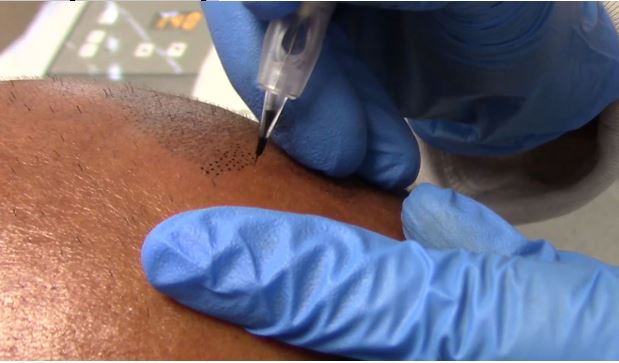
But SMP is not your grandfather’s tattoo.
When used on a shaved but balding head, the appearance of well-placed SMP can fool even the closest observer into thinking the shaved head is a style choice instead of expert camouflage.
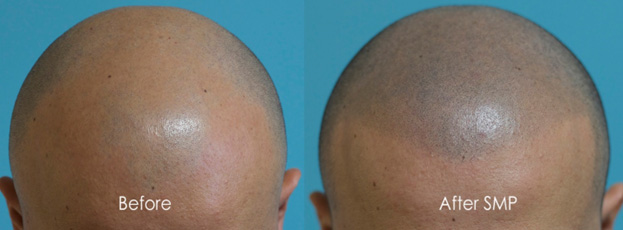
Before and after SMP on a bald scalp.
When employed to enhance the density of existing hair or to supplement a comprehensive hair transplant, the naked eye will see fullness and overall hair coverage where no additional hair exists. Scalp micropigmentation is how the expert hair surgeon becomes neither technician, nor clinician, but more magician.
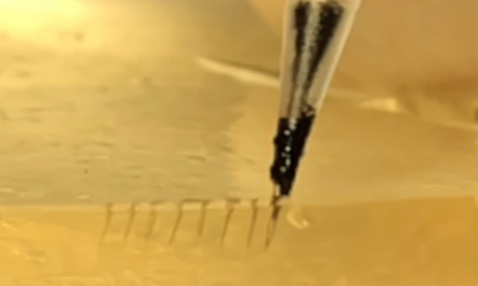
Medical Grade Ink Depth is greater than traditional tattoos.
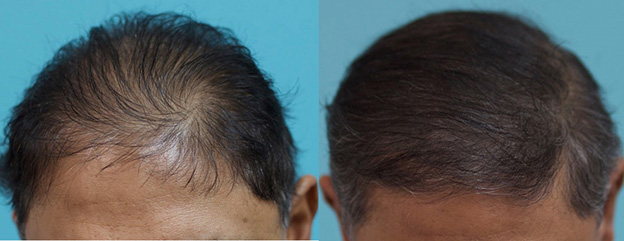
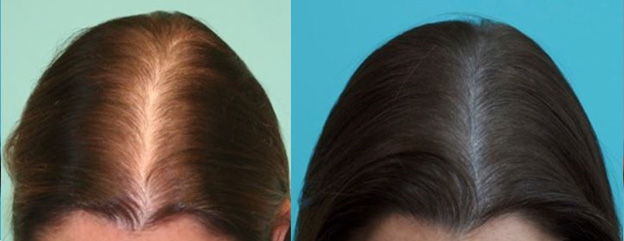
Characteristics of SMP
SMP is microscopic, pointillistic (i.e., tiny dots), and shallow medical-grade tattooing. Above all, the desired effect is that of a natural appearance for the patient. To achieve this, needle penetration depths are shallow (usually 0.5mm) across the scalp; because the scalp has only three layers at the top (vertex/crown), and five layers at its edges, the needle depth must be constantly adjusted to keep the pigment in the topmost layers of the scalp skin (known as the epidermis). This requires specialized machines, needles, and pigments specifically made for scalp micropigmentation. Additionally, since the scalp has the highest concentration of oil glands anywhere on the body, pigment must not be allowed to penetrate deeply, otherwise the pigment will spread in the fat and oils, leading to significant and blotchy discoloration.2
An easy example of this pigmentation error can be seen in patients who have allowed a conventional tattoo artist to decorate their scalp. In these cases, tattoo ink is generally placed deeper than optimal or with a larger needle, causing it to spread under the skin. Also, if a conventional tattoo pigment is used, the color can change from black or brown to a shade that would not naturally occur on a human head, like blue or orange. (See examples below)
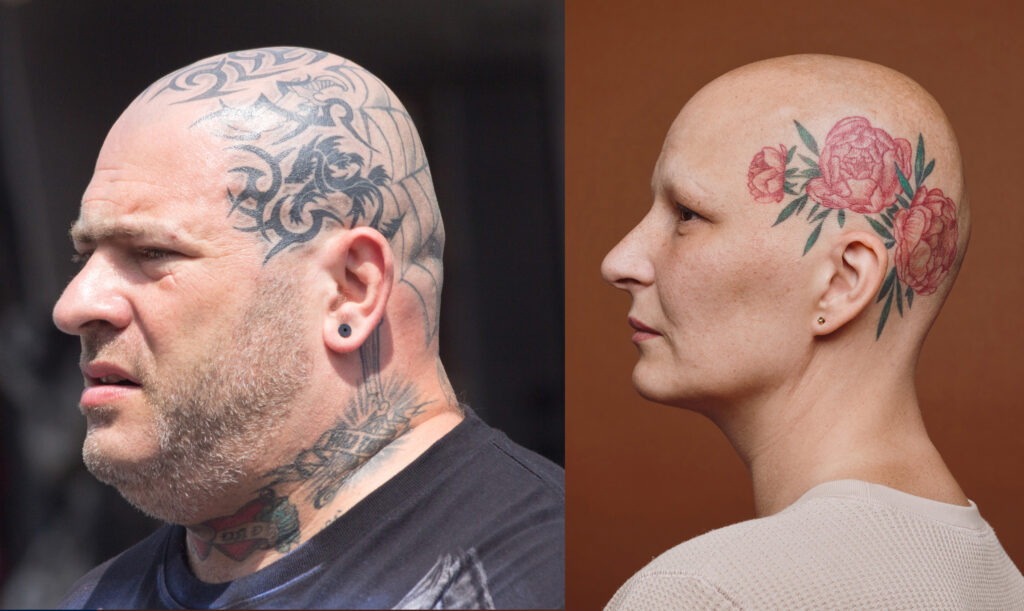
Traditional tattoo of the scalp.
SMP is an Art Unlike Normal Tattooing
Generally speaking, SMP is not supposed to imitate the appearance of hair as a line because all-natural hair moves if it has any length. If a hair does not move and is surrounded by moving hairs, it does not look natural and stands out instead of blending. In actuality, SMP is supposed to imitate the appearance of the pore that hair comes out of. It imitates the appearance of very short hair or hair “on end.”
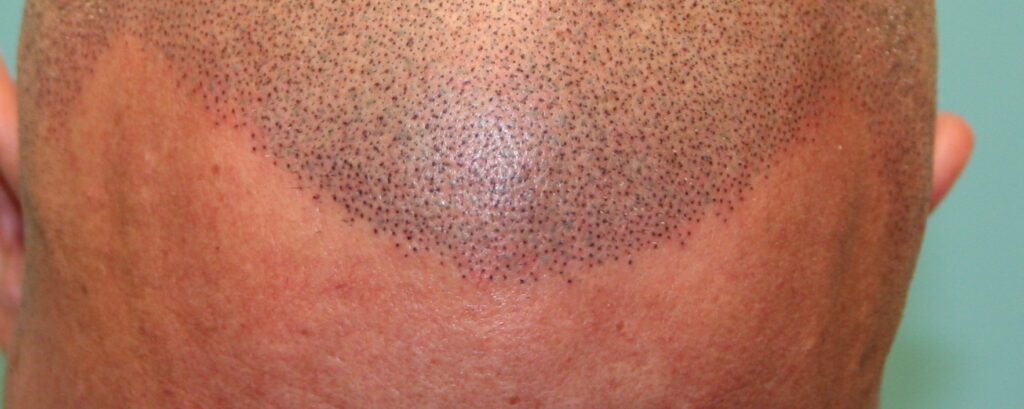
Also, in most cases, SMP is not intended to match the patient's hair color. Since the follicle itself is a tiny hole (pore) in the scalp with 1-3 hairs growing out of each one, the follicle looks like a tiny circular shadow from a normal viewing distance. SMP is trying to imitate that shadow.
To help visualize, imagine the opening of a miniature cave, with the hairs being the multiple ropes of the intrepid spelunker’s layout out of the mouth. The SMP is the shadow of the entrance of the cave…NOT the ropes! In essence, this technique is taking advantage of how we see – and creating a visual illusion of density. Visual inputs from your eyes are interpreted by the brain (a process termed “visualization”), turning a 2-dimensional image into a 3-dimensional one. This happens because, when looking at a normal scalp, your eye considers how many shadows it sees to count “cave openings” …and ignores the ropes.3,4
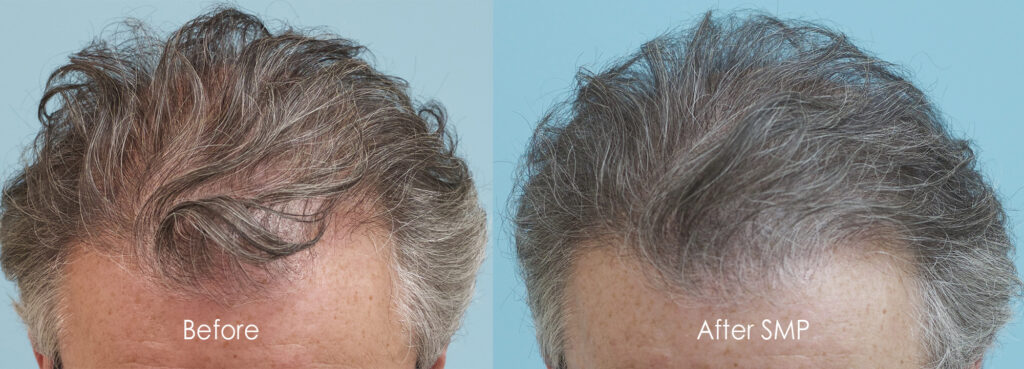
It is a little-known fact that black tattoo pigment is often created by mixing many different colors together. Black tattoos can also be created simply with carbon (like coal or ash). In fact, using carbon is one of the most ancient forms of tattooing for which we have evidence. It is also less concerning since many ingredients in tattoo pigments are known to be toxic or carcinogenic.5 Preferred SMP pigment is a carbon-only pigment, not a mix of all the colors of the rainbow. This allows the SMP artist to create grayscale dots that imitate shadows of pores most accurately.
This concept of black tattoo ink is a mix of colors OR “just plain black” can be difficult to grasp at first for those unfamiliar with the physiology of tattoos. To help understand, think of the difference between a child using a black crayon to color a drawing OR mixing all the colors in the box together to create black. If the child uses a black crayon, they can choose to make light black (gray) or dark black. But if all the colors are mixed together, the only option is the pseudo-black of the color mix with various alternative colors occasionally peeking through.
The use of a grayscale pigment is why expertly placed SMP will blend with any hair color and will look natural even if a person’s hair goes gray over time.
How Does SMP Work with Hair Surgery to Create Optimal Looks?
SMP works best in an “all or nothing” manner. It looks good on a head that is completely shaved because it can fill in any bald spot to look like the shaved hair. The SMP artist will fill in the blank areas with a density that matches the surrounding hair density – generally the back, top, and front of the head. In these cases, patients can either skip surgery entirely OR get hair transplants to place at least some real hair (10-20 grafts per centimeter is a reasonable density goal) in the hairline or crown to add to the realistic texture and appearance. This helps because patients are gratified just to be able to touch some hair on their own head, even if they are going for the “shaved look.”

SMP also works very well in heads with hair everywhere (over 20 grafts per centimeter), but just not as dense as the patient would like. So, if a patient has already had a hair transplant but does not have enough hair to achieve their density goals, SMP might be the next best step in treatment. Similarly, those patients who have scalp visibility that bothers them but not enough space to fit hair grafts surgically without damaging existing hair find that SMP makes the whole area look improved without surgery.
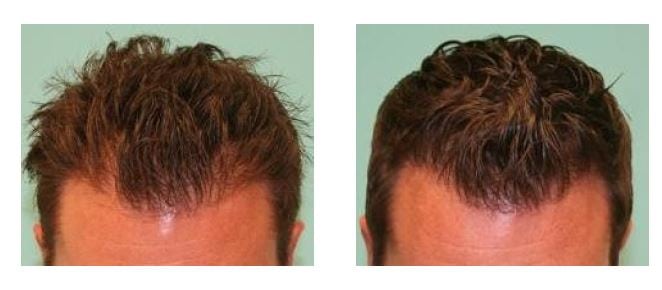 SMP also works best in patients with a high contrast between their hair and their scalp skin due to the “optical illusion” characteristics of the scalp micropigmentation itself. Thus, very dark hair on a light scalp background is the perfect “use case” for SMP. Lighter hair colors, graying or white hair, and even dyed hair colors (pink! green! etc.) also have a superior outcome for SMP, provided the proper grayscale pigment is used. Sometimes, an SMP practitioner will try several versions of pigment to see what works best, and this is also known as a “test patch.”
SMP also works best in patients with a high contrast between their hair and their scalp skin due to the “optical illusion” characteristics of the scalp micropigmentation itself. Thus, very dark hair on a light scalp background is the perfect “use case” for SMP. Lighter hair colors, graying or white hair, and even dyed hair colors (pink! green! etc.) also have a superior outcome for SMP, provided the proper grayscale pigment is used. Sometimes, an SMP practitioner will try several versions of pigment to see what works best, and this is also known as a “test patch.”
SMP is often used to hide the scars of hair surgery. Whether the multi-dotted scattergram of scars from a follicular unit excision (FUE) surgery or the linear scar of the traditional surgery method, SMP can visually diminish - and in some cases nearly erase - a scar’s appearance. But be aware that scars – all scars - are the most demanding and difficult situation for placing SMP. It requires considerable effort and skill to get optimal results because the pigment placed into a scar often spreads, fades, and changes color in unpredictable patterns.
Unique Uses for SMP
Scalp micropigmentation can help in a number of unique situations related to hair surgery, including;
- In patients who have a previous linear scar from hair restoration surgery but want to shave their head for an FUE hair transplant, SMP can be used Intraoperatively to camouflage a previous linear scar during surgery. This helps the patient to camouflage their shaved donor area for 1-2 weeks while the remaining donor hair is regrowing. SMP placed in this circumstance is often temporary, but additional sessions can be performed once healing is complete if desired.
- For those patients who anticipate a higher hairline as they age, combination (or “hybrid”) SMP can reframe the face with a lower, more youthful hairline with temporary pigments for the anterior hairline edge, and more permanent pigments anticipating the mature hairline.
- SMP can be used in patients with burns and scarring alopecias once they have healed in order to restore a more natural appearance. This type of restorative medical pigmentation is intrinsically rewarding, and the highest, best use of this art form. It can renew a person’s self-confidence and be life-changing, but should be attempted only by experts since the consequences of further disfiguring an individual can be tragic.
- Disfigured patients who received hair transplants from unregulated or unlicensed medical professionals can use micropigmentation to restore a more natural appearance. Unfortunately, Black Market (medical tourism) botched hair transplants have proliferated exponentially in recent years leading to patchy and moth-eaten appearances for both donor and recipient areas. Cases such as these will commonly choose to go with a shaved-head look if the damage has been extensive, but the final result can still be remarkably natural and satisfactory for the patient
- Transitioning patients who experience hair loss prior to OR as part of their change (mostly male to female, or post facial feminization surgery) can use SMP to enhance the density of their preferred hairstyle. Scalp micropigmentation is particularly useful when hormonal therapy cannot restore full hair density where previous male pattern hair loss existed or where scars from facial feminization surgery (FFS) have left an odd pattern of hair growth.
Where should SMP be avoided?
Scalp micropigmentation can look either like hair that is more dense or like shaved hair. But just as it would be odd to have only part of a head shaved, so too does SMP look odd when there is a mix of haired and non-haired areas on a scalp. If a scalp has a completely bald area next to an area with longer hair (>~3mm) and relatively good density (>~30 follicles per centimeter), SMP should be avoided. In these cases, transplanting hair to the balding area may make the patient a more suitable candidate.
Some scalp skin is unsuited to scalp micropigmentation. For instance, in some scalps, the pigment may not stay, even after repeated attempts. Some scalps are too oily or flaky for the pigment to be applied effectively, and even additional “scalp prep” methods may not work to make those patients suitable candidates for effective SMP. Active scalp conditions where inflammation is involved like a “scarring alopecia,” psoriasis, or alopecia areata are particularly at risk for poor outcomes. These scalps should NOT have SMP applied until the areas are completely stable and disease-free for 2-3 years.
SMP should be avoided after hair transplantation for at least a year to give time for the newly transplanted hair to grow in. Since this process takes 11-12 months, it can be difficult to wait! However, patience is best because hair grows in with differing densities and at different rates, and optimal scalp micropigmentation takes this variable into account. Without knowing where the hair will grow, SMP will be placed too densely in one area and not densely enough in another, leading to an uneven appearance. Another reason to wait is that the same cells that remove pigment are the cells that are present in the skin during the healing process – and since the healing takes a full year, SMP placed before that time risks premature fading and suboptimal results.11,12,13,14
SMP Removal
Any pigment in the skin changes appearance over time. “Permanent” pigments can fade, and “temporary“ pigments never leave. UV light, in particular, will fade scalp micropigmentation pigments more quickly than otherwise, so sun protection for the head after treatment is essential. Well placed SMP lasts 5-10 years, with some patients preferring a “touch-up” session yearly to enhance the 3D appearance.
In cases where SMP needs to be removed from a scalp, a tattoo removal laser can accomplish this in as little as a single session with little discomfort or downtime for the patient. Some cases require additional sessions if the pigment has been repeatedly applied or placed/migrated deeper in the layers of scalp skin, but hair growth is usually undisturbed. This should be contrasted with the removal of a traditional tattoo from a scalp, which definitely risks hair loss, and is yet another reason traditional tattooing supplies and equipment should not be used to SMP. Two additional possible treatments for SMP removal include salabrasion (with saline), and topical tattoo removal creams, both of which can be effective (although sometimes irritating) options. Only those who are trained and specializing in scalp micropigmentation should perform these treatments, and in some locations around the world, only trained and licensed medical professionals should operate dermatologic lasers.
One final word of warning: SMP removal is typically an all-or-nothing endeavor. In other words, it is suboptimal to remove selective small patches of micropigmentation because - once cleared - that spot will never match the older micropigment dots around it. New SMP in a single area will always look crisp and dark - different from the surrounding SMP. So if SMP becomes unsightly in a single area or is overapplied over several treatments, the whole of the pigmented areas need to be taken back to square one (i.e., with all pigment removed). Thankfully, this is often not a problem at all with professionally placed SMP, and removal of an entire pigmented head can be accomplished in a single 30-minute session with only minor discomfort and little to no downtime for the patient.
How to Find Expert SMP?
Tattoo artists with expertise in artistic tattooing are common. SMP specialists are clearly not as common, but their training and body of work can identify them. Most SMP practitioners who take the time to specialize in SMP will only perform micropigmentation and not generalized body art tattooing because the equipment, techniques, and pigments are different. If the artist works independently of a hair surgeon's office, look for clear, reproduced patterns of photos with consistent lighting and positioning for evidence of the types of cases they specialize in. Cell phone photos are notorious for distorting head and scalp images unless the settings are adjusted. If you can see SMP examples in person, the evaluation is even better. With their expertise in surgically creating detailed hair patterns, many hair surgeons will also perform their own SMP.
International trainers with long histories in this field include the Finishing Touches Group in the UK and Beauty Medical out of Italy, both of which provide a certificate of training to their trainees. There is currently no international licensing body for scalp micropigmentation practitioners, and medical-grade tattooing is still less common than body art tattooing. A serious hair surgeon will have a network of references and resources to help take care of their patients if they themselves do not perform specialized treatments like SMP.
Future of SMP
Scalp micropigmentation is already an indispensable tool for the well-rounded hair transplant surgeon; although additional high-quality training opportunities are still needed, the use of SMP will continue to expand. Even now, advances in pigment-applying technology with improved needles and equipment, high-pressure needle-less machines, and advanced pigments are beginning to improve the results for patients worldwide. It is probable that all subsequent hair transplants will incorporate some degree of scalp micropigmentation in order to optimize patient outcomes in the future.
About Sara Wasserbauer, MD
Sara Wasserbauer, M.D., A.B.H.R.S, F.I.S.H.R.S is a Diplomate of the American Board of Hair Restoration Surgery - Fellow of the International Society of Hair Restoration Surgery and is currently located in Walnut Creek, California. Dr. Wasserbauer writes a monthly feature article for the ISHRS Hair Transplant Forum International. She is a leader in the utilization of scalp micropigmentation (SMP) and has led SMP workshops and trained physicians and their staff in the art and science of the proper use and application of SMP.
References:
- “TrichoPigmentation” https://www.beautymedical.it/en/milena-lardi/ “scalp has the highest concentration of oil glands” https://en.wikipedia.org/wiki/Scalp
- “your eye considers how many shadows it sees” https://www.sciencedaily.com/releases/2007/08/070820135833.htm
- “visualization turns a 2-dimentsional image into a 3-dimensional one” https://www.allaboutvision.com/eye-care/eye-anatomy/optical-illusions-and-the-human-eye/
- “many ingredients in tattoo pigments are known to be toxic or carcinogenic” https://www.fda.gov/consumers/consumer-updates/think-you-ink-tattoo-safety
- True, A. Garg, S. Garg, Practical Guide to Hair Transplantation, Chapter 26 (Scalp Micropigmentation by Sara Wasserbauer MD), First Ed. 2021, ISBN: 9789390553242
- Personal email communication with N. Farjo MD
- Personal email communication with E. Furlong
- https://fightthefight.ishrs.org, Accessed 3/4/24
- Deschamps-Braly, Facial Feminization Surgery: The Journey to Gender Affirmation, Chapter 15, (Hair Transplants by Sara Wasserbauer MD) Second Edition, 2021, ISBN-13 978-195009139
- “hair grows in with differing densities and at different rates” https://sciencenotes.org/why-hair-grows-faster-on-one-side/
- Bernard, Bruno A. (2016) Advances in Understanding Hair Growth. F1000 Faculty Rev-147. doi: 12688/f1000research.7520.1
- Hayashi S., Miyamoto I., Takeda K. (1991) Measurement of human hair growth by optical microscopy and image analysis.Br J Dermatol. 125(2):123-9.
- Van Neste, D. (2004) Thickness, medullation and growth rate of female scalp hair are subject to significant variation according to pigmentation and scalp location during ageing. Eur J Dermatol. 14(1):28-32.
- “enhance the 3D appearance”
- Lam, K. Williams, Hair Transplant 360, Chapter 36 (Scalp Micropigmentation by Sara Wasserbauer MD, Fourth ed. 2022 ISBN-13: 978-9354652011
This is another example of the visual illusion characteristic of SMP. A slightly faded gray dot will look more distant than a crisp dark one, even if the dots are the same size, thus appearing 3-dimensional.
https://www.cns.nyu.edu/~david/courses/perception/lecturenotes/depth/depth-size.html
